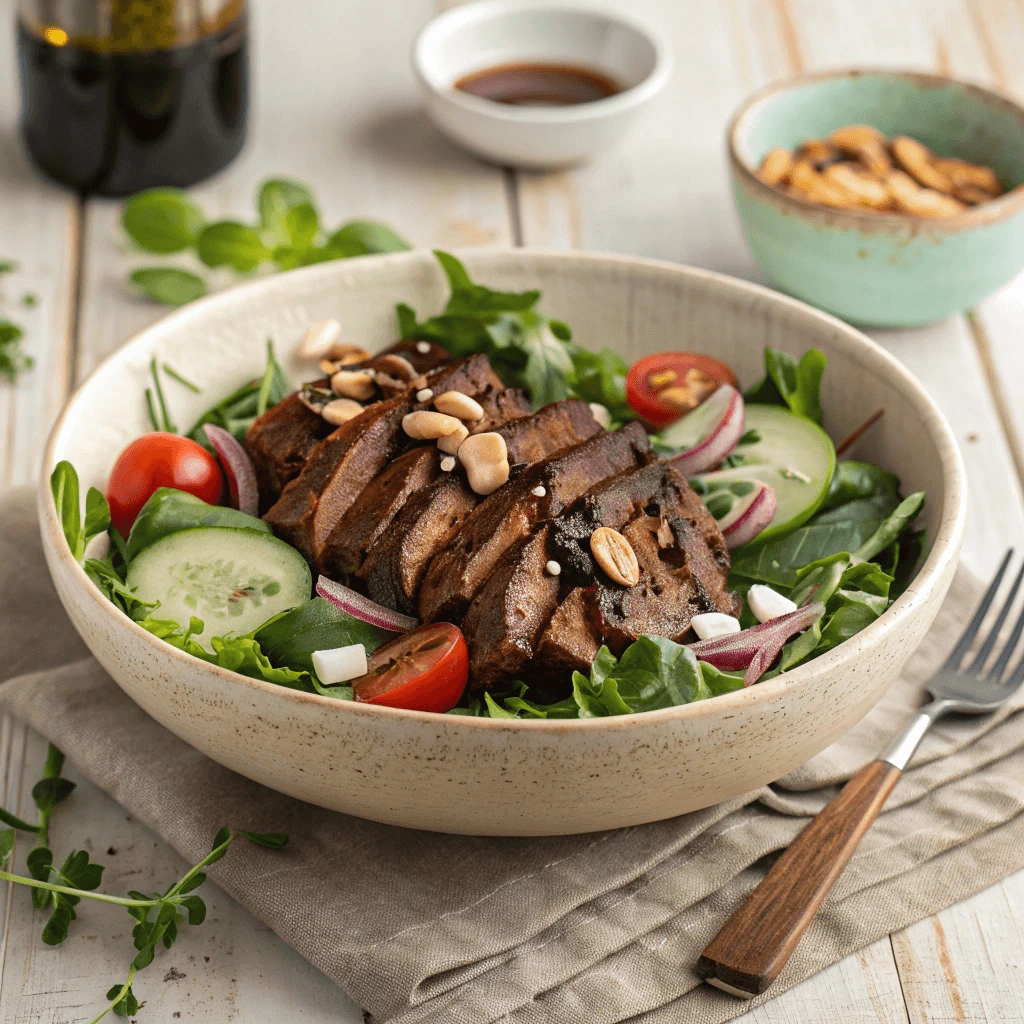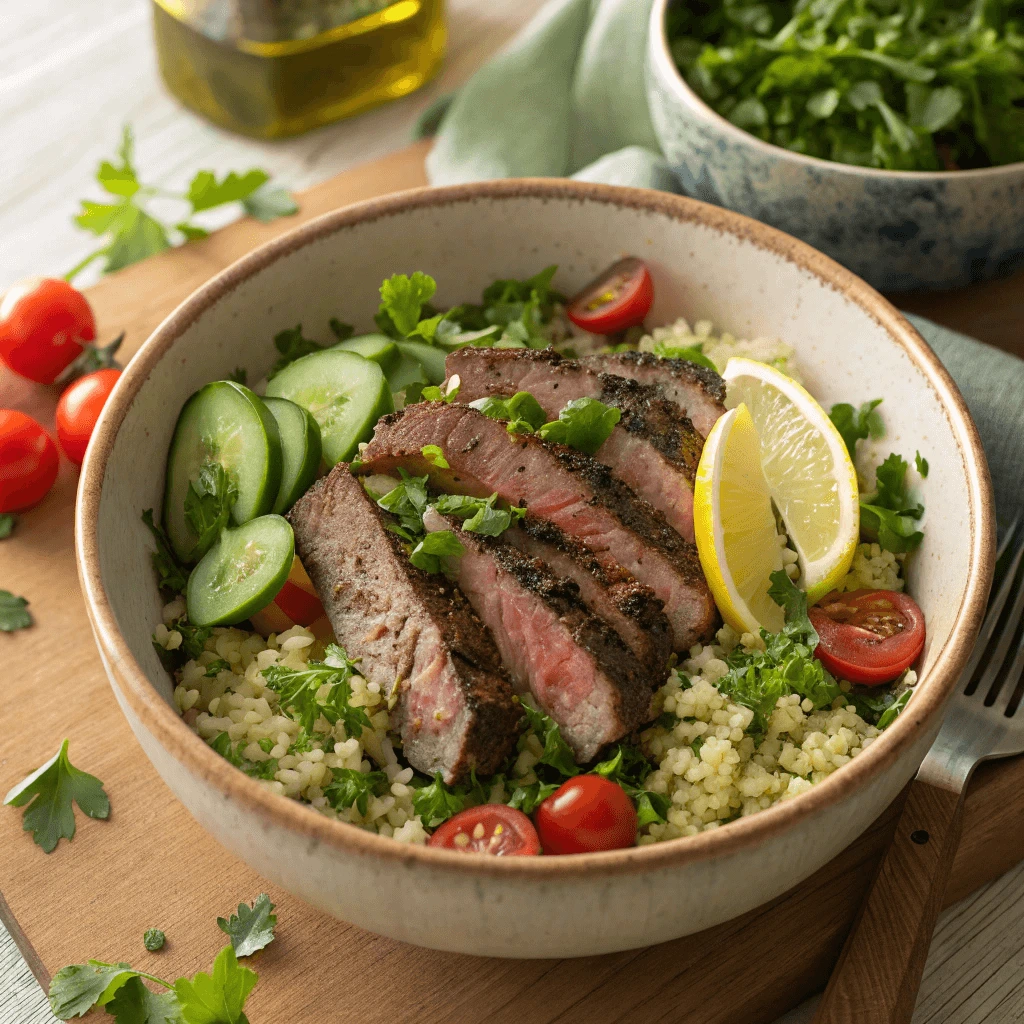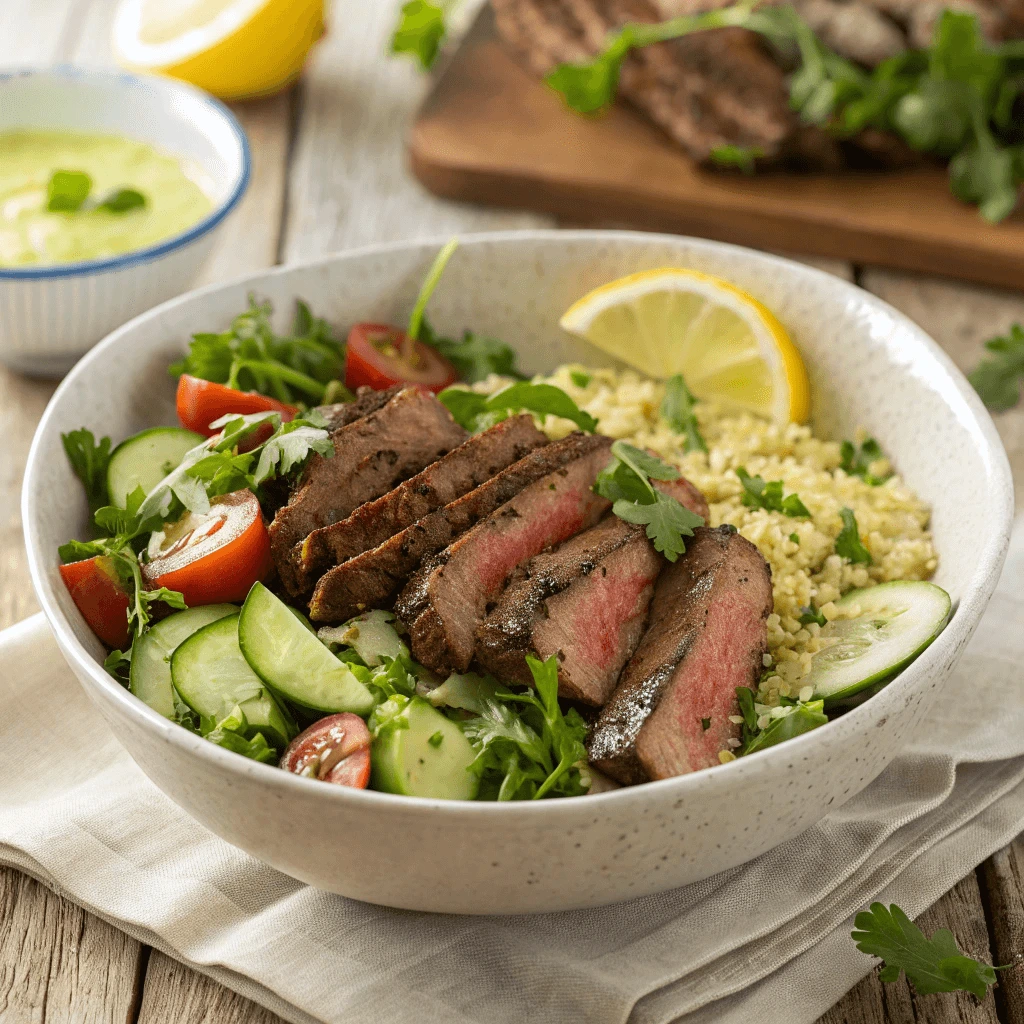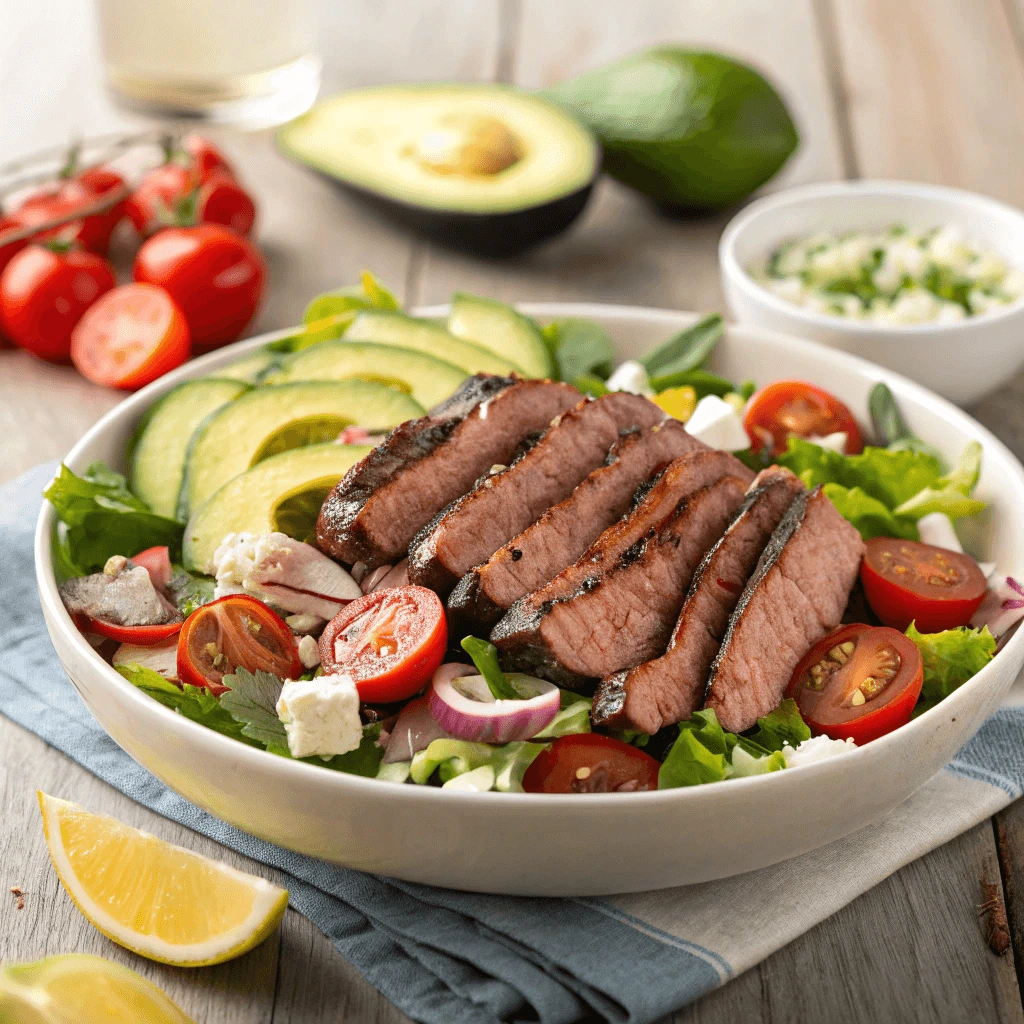Looking for delicious meals that come together quickly without sacrificing flavor or nutrition? Steak salad recipes offer the perfect solution. Packed with protein-rich steak, fresh greens, and vibrant vegetables, these salads provide a satisfying and wholesome option for any time of day. Whether you prefer grilled ribeye, pan-seared sirloin, or tender flank steak, there’s a flavorful steak salad recipe to suit your taste. Explore easy, nutritious ideas that bring bold flavors and simple prep to your kitchen table.
Quick and Easy Steak Salad Recipes

Grilled Ribeye Steak Salad with Balsamic Vinaigrette
Grilled ribeye steak adds rich flavor and tenderness to this classic salad. Its marbled fat keeps the steak juicy and delicious, making it perfect for steak salad recipes.
Selecting and Grilling the Ribeye
Choose a ribeye steak about 1-inch thick with good marbling. Season it simply with salt and pepper. Grill the steak over medium-high heat for 4-5 minutes per side for medium-rare. After grilling, let it rest for 5-10 minutes to keep the juices inside.
Preparing the Salad and Dressing
Use mixed greens like arugula, spinach, and romaine as the salad base. Add cherry tomatoes and cucumber slices for freshness. Whisk balsamic vinegar, olive oil, Dijon mustard, and garlic to make a tangy vinaigrette.
Assembling the Salad
Slice the rested ribeye thinly against the grain and lay it over the dressed greens. Toss gently and add optional toppings like crumbled feta for extra flavor. This steak salad offers a quick, flavorful, and nutritious meal.
Pan-Seared Sirloin Salad with Avocado and Cherry Tomatoes
This pan-seared sirloin salad combines tender, flavorful steak with creamy avocado and juicy cherry tomatoes. It’s a quick and nutritious choice perfect for any meal, bringing fresh ingredients and hearty protein together in one bowl.
Selecting and Preparing the Sirloin
Choose a sirloin steak known for its balance of tenderness and flavor. Season both sides generously with salt, pepper, and your favorite herbs or spices. Heat a skillet over medium-high heat and add a small amount of olive oil. Sear the steak for about 3-4 minutes on each side to reach medium-rare or adjust cooking time to your liking.
Resting and Slicing the Steak
Once cooked, transfer the steak to a cutting board and let it rest for 5-7 minutes. Resting allows the juices to redistribute, making each bite juicy and tender. Slice the steak thinly against the grain to maximize tenderness and texture in your salad.
Preparing the Salad Ingredients
While the steak rests, prepare your salad base. Combine fresh mixed greens or baby spinach with halved cherry tomatoes, diced avocado, and thinly sliced red onions. These ingredients add vibrant color, healthy fats, and a burst of freshness that complements the savory steak.
Assembling and Dressing the Salad
Place the greens and vegetables in a bowl, then layer the sliced sirloin on top. Drizzle with your favorite dressing—try a lemon vinaigrette or balsamic reduction for a tangy contrast. Toss gently to coat the ingredients evenly without bruising the avocado.
This pan-seared sirloin salad with avocado and cherry tomatoes delivers a satisfying mix of flavors and textures. It’s a quick, easy recipe that fits perfectly into your collection of steak salad recipes.
15-Minute Flank Steak Salad with Spinach and Fresh Herbs
This 15-minute flank steak salad offers a fast, fresh, and flavorful meal perfect for busy days. The lean, tender flank steak pairs beautifully with nutrient-packed spinach and fragrant fresh herbs, creating a balanced and healthy dish.
Choosing and Cooking the Flank Steak
Select a lean flank steak, known for its bold flavor and quick cooking time. Season the steak generously with salt, pepper, and a touch of garlic powder. Heat a grill pan or skillet over medium-high heat, then cook the steak for about 4 minutes per side to reach medium-rare. Adjust the cooking time if you prefer your steak more done.
Resting and Slicing the Steak
After cooking, transfer the steak to a plate and let it rest for 5 minutes. Resting helps the juices redistribute, keeping the meat tender and juicy. Slice the steak thinly against the grain to enhance tenderness and make it easier to enjoy in your salad.
Preparing the Salad Base with Spinach and Herbs
While the steak rests, prepare your salad. Use fresh baby spinach as the leafy base—it’s packed with vitamins and adds a mild, slightly sweet flavor. Add chopped fresh herbs such as parsley, basil, and mint. These herbs brighten the salad with aromatic notes and add a fresh twist to every bite.
Assembling and Dressing the Salad
Place the spinach and herbs in a large bowl, then add thinly sliced steak on top. Drizzle with a simple dressing made from olive oil, lemon juice, salt, and pepper. Toss gently to combine, ensuring every bite delivers a harmonious blend of flavors.
This 15-minute flank steak salad with spinach and fresh herbs offers a quick, nutritious option packed with protein, vitamins, and bold tastes. It’s perfect for a light lunch or dinner that doesn’t compromise on flavor.
Flavorful Ingredients to Elevate Your Steak Salad
Choosing the Best Steak Cuts
Selecting the right steak cut plays a crucial role in crafting the perfect steak salad. Each cut offers unique flavors, textures, and cooking styles that impact your salad’s taste and overall experience.
Ribeye: Rich and Juicy
Ribeye steak stands out for its rich marbling and tenderness. The fat melts during cooking, infusing the meat with a juicy, buttery flavor. Ribeye works well when grilled or pan-seared, and its robust taste pairs beautifully with bold salad ingredients like blue cheese or caramelized onions.
Sirloin: Lean and Flavorful
Sirloin provides a leaner option without sacrificing flavor. It has a firmer texture and a slightly beefier taste than ribeye. Sirloin cooks quickly and remains tender when sliced thinly against the grain. This cut suits lighter salads with fresh greens and zesty dressings, adding a satisfying protein boost.
Flank: Lean and Versatile
Flank steak features a lean profile with a pronounced grain, offering a slightly chewier texture. It absorbs marinades well, making it ideal for flavor-packed salads. Cooking flank steak quickly over high heat and slicing it thinly ensures tenderness. It pairs perfectly with fresh herbs and crisp vegetables.
Making Your Choice
Consider the salad style and your taste preferences when choosing between ribeye, sirloin, and flank. Ribeye offers indulgence, sirloin balances lean and flavorful, while flank adds versatility with bold marinades. Using the right cut elevates your steak salad from good to unforgettable.
Fresh Greens and Vegetables
Choosing the right greens lays a solid foundation for any steak salad. Among popular options, arugula, romaine, and spinach each contribute unique flavors, textures, and health benefits that elevate your meal.
Arugula: Peppery and Bold
Known for its peppery bite, arugula adds a lively, spicy kick to salads. Its tender leaves provide a gentle crunch, which contrasts nicely with the richness of steak. Moreover, arugula pairs exceptionally well with tangy dressings and sharp cheeses, bringing complexity to the flavor profile.
Romaine: Crisp and Refreshing
Romaine lettuce stands out due to its crisp texture and mild, slightly bitter flavor. Because of its sturdiness, romaine holds up well under heavier toppings and creamy dressings. As a result, it adds a refreshing crunch that balances the tender, juicy steak perfectly.
Spinach: Soft and Nutritious
Spinach offers a softer texture along with a mild, slightly sweet taste. Rich in vitamins A and C, iron, and antioxidants, it significantly boosts the nutritional value of your salad. In addition, spinach’s subtle flavor complements both bold and delicate dressings alike.
Combining Greens for Balance
To create a well-rounded salad, try mixing these greens together. This combination balances peppery, crisp, and tender textures, making every bite interesting and flavorful. Furthermore, adding fresh vegetables like cucumbers, cherry tomatoes, or bell peppers enhances the salad’s taste and nutritional profile.
Adding Healthy Fats
Incorporating healthy fats into your steak salad not only enhances flavor but also boosts nutrition. Avocado, nuts, and olive oil deliver essential fats that support heart health and improve the salad’s texture.
Creamy Avocado for Smooth Richness
Avocados add a creamy texture and mild, buttery flavor that complements the savory steak. They contain monounsaturated fats, which help reduce bad cholesterol and support brain function. Slicing or dicing avocado into your salad enriches each bite with smoothness and nutrition.
Crunchy Nuts for Texture and Nutrition
Adding nuts like walnuts, almonds, or pecans introduces a satisfying crunch. These nuts provide healthy fats, protein, and fiber, making your salad more filling. Toasting nuts lightly before adding them enhances their flavor and adds a warm, nutty aroma.
Olive Oil: The Heart-Healthy Dressing Base
Using extra virgin olive oil as a dressing base infuses the salad with fruity, aromatic notes. Olive oil contains antioxidants and anti-inflammatory properties that benefit overall health. Combine olive oil with lemon juice or balsamic vinegar for a simple yet flavorful dressing.
Why Healthy Fats Matter
Healthy fats help your body absorb fat-soluble vitamins from vegetables and improve satiety, keeping you full longer. They also add depth to flavors, balancing the crispness of greens and the richness of steak.
Nutritious Benefits of Steak Salad Recipes

High-Protein Content for Muscle and Energy
Protein plays a vital role in building and repairing muscles while providing sustained energy throughout the day. Including steak in your salad offers a rich source of high-quality protein that supports overall health and fitness goals.
Protein’s Role in Muscle Growth
Consuming adequate protein helps your body repair muscle fibers after exercise or daily wear and tear. Steak provides all essential amino acids, making it a complete protein source. This completeness supports efficient muscle recovery and growth.
Boosting Energy Levels
Protein also contributes to maintaining steady energy levels. Unlike simple carbohydrates, protein breaks down more slowly, helping to avoid energy spikes and crashes. Eating steak salad keeps you feeling full and energized longer, preventing mid-day slumps.
Supporting Metabolism and Weight Management
High-protein meals can increase your metabolism by boosting the number of calories your body burns during digestion. Additionally, protein’s satiating effect reduces cravings, which supports healthy weight management. Including steak in salads makes meals both satisfying and beneficial for weight control.
Enhancing Overall Nutrition
Steak doesn’t just supply protein; it also provides important nutrients such as iron, zinc, and B vitamins. These elements support oxygen transport, immune function, and energy production. Adding steak to your salad boosts its nutritional value significantly.
Incorporating high-protein steak into your salads creates a powerful meal that fuels your muscles, sustains your energy, and contributes to a balanced diet.
Nutrient-Dense Greens and Vegetables
Adding a variety of nutrient-dense greens and vegetables to your steak salad enhances both flavor and health benefits. These ingredients supply essential vitamins, minerals, and antioxidants that support overall wellness.
Vitamins and Minerals Boost Immunity
Leafy greens like spinach, kale, and arugula pack vitamins A, C, and K. These vitamins strengthen your immune system and promote healthy skin and eyes. Vegetables such as bell peppers and tomatoes contribute additional vitamin C, which helps your body fight infections and heal wounds.
Fiber Supports Digestion and Satiety
Greens and vegetables contain dietary fiber that aids digestion by promoting regular bowel movements. Fiber also helps you feel full longer, reducing overeating and aiding in weight management. Including plenty of vegetables in your steak salad ensures you get enough fiber in your diet.
Antioxidants Combat Oxidative Stress
Many vegetables are rich in antioxidants, compounds that protect your cells from damage caused by free radicals. For example, dark leafy greens and colorful vegetables like carrots and tomatoes contain antioxidants that may lower inflammation and reduce the risk of chronic diseases.
Hydration and Low Calories
Vegetables such as cucumbers and celery have high water content, which helps keep you hydrated. Despite their nutrients, they contain very few calories, making them excellent additions to nutrient-dense salads without adding unnecessary bulk.
Combining Greens and Vegetables for Maximum Benefits
Mixing various greens and colorful vegetables provides a broad spectrum of nutrients. For instance, pairing bitter arugula with sweet cherry tomatoes and crunchy cucumbers creates a satisfying texture and nutrient balance that complements your steak perfectly.
Incorporating nutrient-dense greens and vegetables transforms your steak salad into a powerhouse of health benefits while delivering fresh, vibrant flavors.
Healthy Fats That Support Heart Health
Adding healthy fats to your steak salad improves both flavor and heart health. These fats help lower inflammation, improve cholesterol balance, and support cardiovascular function overall.
Understanding Healthy Fats
Primarily, healthy fats include monounsaturated and polyunsaturated fats. Unlike harmful saturated and trans fats, these good fats lower bad LDL cholesterol while raising good HDL cholesterol. For example, avocados, nuts, seeds, and olive oil provide excellent sources of these beneficial fats.
Avocados: Creamy and Heart-Friendly
Thanks to their high monounsaturated fat content, avocados help reduce blood pressure and decrease the risk of heart disease. Including sliced avocado in your steak salad adds a creamy texture and delivers essential nutrients such as potassium, which supports healthy blood pressure levels.
Nuts and Seeds: Crunch and Nutrition
Nuts like almonds and walnuts, along with seeds such as chia and flax, supply polyunsaturated fats, including omega-3 fatty acids. These fats reduce inflammation and promote brain and heart health. Additionally, sprinkling nuts and seeds over your salad gives it a satisfying crunch and a nutritional boost.
Olive Oil: The Mediterranean Secret
Extra virgin olive oil serves as a cornerstone of the Mediterranean diet due to its powerful antioxidants and anti-inflammatory properties. Using olive oil as a base for your dressing enhances flavor and promotes heart health by improving blood vessel function.
How Healthy Fats Benefit Your Heart
Healthy fats maintain flexible arteries and prevent plaque buildup, thus lowering the risk of heart attacks and strokes. Furthermore, they aid in balancing blood sugar levels and improving insulin sensitivity, which contributes to overall cardiovascular wellness.
Delicious Steak Salad Dressing Ideas

Classic Balsamic Vinaigrette Recipe
A classic balsamic vinaigrette adds a tangy and slightly sweet flavor that pairs perfectly with steak salad recipes. Making it at home lets you control the ingredients and avoid preservatives.
Ingredients
You’ll need:
- ¼ cup balsamic vinegar
- ½ cup extra virgin olive oil
- 1 teaspoon Dijon mustard
- 1 teaspoon honey (optional)
- 1 minced garlic clove
- Salt and pepper to taste
How to Make It
Start by whisking balsamic vinegar, mustard, honey, and garlic together. Slowly add olive oil while whisking to combine and emulsify the dressing. Season with salt and pepper, then whisk again to blend all flavors.
Why It Works
The acidity of balsamic vinegar balances the rich, savory flavor of steak. This vinaigrette enhances fresh greens and vegetables without overpowering them, making every bite fresh and flavorful.
Creamy Avocado and Herb Dressing
Creamy avocado and herb dressing brings a fresh, rich flavor to steak salads while providing healthy fats and antioxidants. This versatile dressing is easy to prepare and complements a wide variety of salad ingredients.
Why Choose Avocado for Your Dressing?
Avocados contain healthy monounsaturated fats that help improve heart health and keep you full longer. Their creamy texture eliminates the need for heavy mayonnaise or sour cream, making the dressing lighter and more nutritious. Additionally, avocados provide vitamins E and C, which protect cells from damage and support immune function.
Fresh Herbs Add Vibrant Flavor
Using fresh herbs like cilantro, parsley, or basil enhances the dressing’s flavor profile with bright, aromatic notes. These herbs also offer antioxidant and anti-inflammatory benefits. For instance, parsley provides vitamin K, which plays a vital role in blood clotting and bone health, while cilantro may help detoxify heavy metals in the body.
Simple Ingredients and Easy Preparation
You only need a few simple ingredients to make this dressing: ripe avocado, fresh herbs, garlic, lemon or lime juice, olive oil, salt, and pepper. Start by blending the avocado with herbs and garlic until smooth. Then, slowly drizzle in olive oil and citrus juice for the perfect balance of creaminess and tang. Season to taste and adjust the consistency with a little water if needed.
Versatility and Serving Suggestions
This creamy avocado and herb dressing pairs beautifully with grilled steak salads, offering a refreshing contrast to the smoky flavors. You can also use it as a dip for vegetables or a spread for sandwiches. Its healthy fats and vibrant taste make it a crowd-pleaser at any meal.
Lemon and Olive Oil Dressing for a Fresh Twist
Lemon and olive oil dressing adds a fresh, bright flavor to steak salads. It keeps your salad light while enhancing the natural taste of the ingredients.
Why Lemon and Olive Oil?
Lemon juice gives a zesty tang that balances the richness of steak. It also provides vitamin C, which boosts your immune system. Olive oil offers heart-healthy fats that help reduce inflammation and improve cholesterol.
Simple Ingredients
Mix fresh lemon juice, good-quality olive oil, a bit of Dijon mustard, minced garlic, salt, and pepper. Whisk these together until smooth and well combined. This easy dressing lets the flavors of your salad shine.
Customizing Your Dressing
Add fresh herbs like basil or oregano for extra flavor. A pinch of red pepper flakes adds heat, while a little honey can balance the tartness if you prefer. Adjust the lemon and olive oil amounts to your taste.
This lemon and olive oil dressing brings a fresh twist to steak salads, making them tasty and healthy.
Tips and Tricks for Perfect Steak Salads
How to Cook Steak Quickly and Flavorfully
Cooking a delicious steak doesn’t have to take hours. With the right techniques, you can prepare a tender, flavorful steak in a short amount of time. Follow these steps to enjoy a juicy steak that’s perfect for your salad.
Choose the Right Cut
Select thinner cuts like flank, skirt, or sirloin steak for faster cooking. These cuts heat quickly and absorb marinades well, adding extra flavor in less time.
Prepare Your Steak
Before cooking, pat the steak dry with paper towels to ensure a good sear. Season it generously with salt, pepper, and your favorite spices. You can also marinate the steak for 15-30 minutes to boost flavor without slowing down the cooking process.
Use High Heat for a Quick Sear
Heat a skillet or grill pan over high heat until it’s very hot. Add a small amount of oil with a high smoke point, such as avocado or grapeseed oil. Place the steak in the pan and avoid moving it for 2-3 minutes. This allows a flavorful crust to develop.
Flip and Finish Quickly
Turn the steak once and cook the other side for another 2-3 minutes for medium-rare doneness. Adjust the time if you prefer your steak more or less cooked. Use a meat thermometer if you want to be precise: 130°F for medium-rare and 140°F for medium.
Rest Before Slicing
Let the steak rest for 5 minutes after cooking. Resting lets the juices redistribute, keeping the steak moist and tender. Slice the steak thinly against the grain to maximize tenderness.
Resting and Slicing Steak for Maximum Tenderness
Properly resting and slicing your steak makes a huge difference in tenderness and flavor. These simple steps ensure that your steak salad turns out juicy and delicious every time.
Why Resting Matters
After cooking, the steak’s juices concentrate in the center. Resting allows these juices to redistribute evenly throughout the meat. If you slice the steak right away, the juices will spill out, leaving the meat dry and less flavorful.
How Long to Rest
Let your steak rest for about 5 to 10 minutes, depending on its size. Cover it loosely with foil to keep it warm but avoid wrapping it tightly, which can cause steam and sogginess. During this time, the temperature will even out, resulting in a tender bite.
Slicing Against the Grain
Look closely at the steak’s muscle fibers — these form the “grain.” Always slice perpendicular to the grain, cutting across the fibers. This breaks up the muscle and shortens the fibers, making the steak easier to chew.
Thickness of Slices
Cut your steak into thin slices, about a quarter-inch thick. Thin slices help blend the steak smoothly with the salad ingredients and improve the overall eating experience.
Meal Prep Tips for Easy Steak Salad Lunches
Preparing steak salads ahead of time makes healthy lunches quick and hassle-free. Follow these meal prep tips to enjoy fresh, flavorful salads throughout your busy week.
Cook Steak in Batches
Grill or pan-sear a larger portion of steak all at once. This saves time and ensures you have cooked steak ready to use for multiple meals. Once cooked, let the steak rest before slicing it thinly for salads.
Store Components Separately
To keep your salad fresh, store the steak, greens, vegetables, and dressings in separate containers. Mixing everything too early can cause the greens to wilt and the steak to lose its texture.
Prep Fresh Ingredients in Advance
Wash and chop salad greens like spinach, arugula, or romaine. Slice veggies such as cherry tomatoes, cucumbers, and bell peppers. Store them in airtight containers to maintain crispness.
Choose Dressings Wisely
Prepare homemade dressings like balsamic vinaigrette or lemon olive oil in advance. Keep them in small containers and add them right before eating to avoid soggy salads.
Assemble Just Before Eating
Combine steak, greens, veggies, and dressing only when you’re ready to eat. This approach preserves the texture and flavor of each ingredient, making every lunch delicious and satisfying.
Conclusion
Steak salad recipes provide a quick, flavorful, and nutritious way to enjoy meals any time of the day. These steak salad recipes combine fresh ingredients, healthy fats, and tender cuts of steak to create satisfying dishes. By trying different steak salad recipes, you can easily add variety and balanced nutrition to your diet. Whether for lunch or dinner, these steak salad recipes make meal prep simple, delicious, and wholesome. Embrace these steak salad recipes to enjoy tasty and healthy meals every day.
